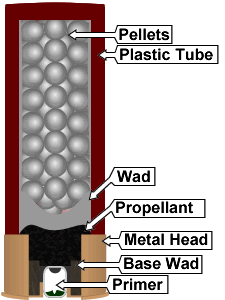- 01: Introduction
- 02: History
- 03: Propellants, Firearms, and Ammunition Development
- 04: Modern Firearms Manufacture
- 05: Small Arms Ammunition
- 06: Evidence Handling Procedures
- 07: Equipment and Instrumentation
- 08: Examination of Firearms
- 09: Cartridge and Shotshell Examination
- 10: Characterization and Evaluation of Fired Projectiles
- 11: Bullet Comparison and Identification
- 12: Gunshot Residue and Distance Determination
- 13: Toolmark Identification
- 14: Communicating Results
- Resources


Shotshell
Home > Small Arms Ammunition > Cartridge Case Manufacture > Shotshell

Shotshell components
Shotshells operate at low pressures, roughly half that produced by the .22 Long Rifle cartridge. Although some military shotshell cartridges were made of brass, by the turn of the twentieth century, the hybrid case was the standard for commercial shotgun cartridges. At that time, the cases consisted of a wound paper body, a horsehair (or other natural fiber) base wad, and a small brass jacket that formed the rim and held the base wad in place.
The paper tube (still used in some modern target shotshells) was made on a long metal mandrel with an outside diameter matching the inside diameter of a finished shotshell. Wide sheets of thin paper were passed through melted wax and wrapped on the rotating mandrel. Dozens of layers of wax were applied to make the case wall the correct thickness. The paper-feed cut the paper and sealed the cut end to the tube. After cooling, the tube was stiff and relatively water resistant due to the wax. The wax also served as the adhesive that prevented the layers from separating. The resulting tube was long enough to be cut into three or more shotshells.
In the 1960s, plastic began to replace paper and fiber components in the sidewalls of shotshell cases. Heat and air pressure was used to produce strong, thin-wall tubes from preformed thermoplastic cylinders. This was adopted by shotshell makers to improve the paper tube case; it was not waterproof and when wet, would swell. Plastic tubes could be made in any length.
Eventually, this experimentation led to the one-piece shotshell case. Rather than cutting tubes to length and adding separate base wads, conventional plastic injection molding methods were used to create a case with an integral base wad. The cases were not truly one piece—they still retained the separate metal head cover. Although the plastic cases were functional without metal heads, the heads made the shells more durable for multiple cycles through shotguns.
One-piece molding added a case feature not possible with paper or the initial plastic process—the “skived” or tapered case mouth. Tapering the walls of a plastic case reduces the force needed to form the crimp that will seal the shell. In spite of the acceptance of the one-piece shotshell case, today’s market contains examples of every tube type, including paper.




